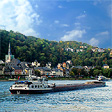SPEYER CATHEDRAL
Four Spires of the Imperial Romanesque Cathedral
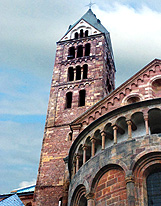 A trading
town near the banks of the Rhine River was chosen by Kaiser
Conrad II as
the
perfect spot to build his great monument to royal power
and religious devotion. With construction first begun in 1030, utilizing
the red sandstone from the nearby Palatine hills (see Castle
Hardenburg),
one of the western medieval world’s greatest churches
rose on a promontory above the river flood plane on the spot of an
earlier basilica church.
The Speyer
Cathedral is
one of the most impressive, and the largest of the remaining churches
of the Romanesque period of the 11th and 12th centuries. When Conrad,
the scion of a noble Franconian family, only with the titles Count of
Speyer and Worms was elected king of the Germans after the last of the
Saxons died out, and crowned Holy Roman Emperor, power shifted to the
Palatine region, and rather like the kings of ancient Egypt, Conrad had
a vision of a monument for himself and his dynasty to follow. The crypt
below the floor of the cathedral nave houses the resting places of eight
medieval German Salian and Staufer emperors and kings, queens and several
bishops, mostly undisturbed for 800 to almost a thousand years.
A trading
town near the banks of the Rhine River was chosen by Kaiser
Conrad II as
the
perfect spot to build his great monument to royal power
and religious devotion. With construction first begun in 1030, utilizing
the red sandstone from the nearby Palatine hills (see Castle
Hardenburg),
one of the western medieval world’s greatest churches
rose on a promontory above the river flood plane on the spot of an
earlier basilica church.
The Speyer
Cathedral is
one of the most impressive, and the largest of the remaining churches
of the Romanesque period of the 11th and 12th centuries. When Conrad,
the scion of a noble Franconian family, only with the titles Count of
Speyer and Worms was elected king of the Germans after the last of the
Saxons died out, and crowned Holy Roman Emperor, power shifted to the
Palatine region, and rather like the kings of ancient Egypt, Conrad had
a vision of a monument for himself and his dynasty to follow. The crypt
below the floor of the cathedral nave houses the resting places of eight
medieval German Salian and Staufer emperors and kings, queens and several
bishops, mostly undisturbed for 800 to almost a thousand years.
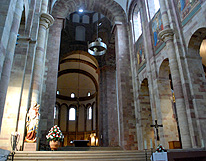 Officially,
the Imperial Cathedral Basilica of the Assumption and St Stephen, the
cathedral
at Speyer is one of the three “Imperial” cathedrals
of the Rhineland, so called because of their relationship to the Holy
Roman Emperors (Kaisers) of the middle-ages. The Kaisers continued long
after medieval times, but never was their stamp put on the land than
the early cathedrals, at Speyer, Worms (see Worms
and Martin Luther)
, and Mainz (see Mainz
Cathedral). Frankfurt is also called
an Imperial cathedral, but never had a Bishopric and is of a later period
(see Frankfurt
Emperor Coronations).
Officially,
the Imperial Cathedral Basilica of the Assumption and St Stephen, the
cathedral
at Speyer is one of the three “Imperial” cathedrals
of the Rhineland, so called because of their relationship to the Holy
Roman Emperors (Kaisers) of the middle-ages. The Kaisers continued long
after medieval times, but never was their stamp put on the land than
the early cathedrals, at Speyer, Worms (see Worms
and Martin Luther)
, and Mainz (see Mainz
Cathedral). Frankfurt is also called
an Imperial cathedral, but never had a Bishopric and is of a later period
(see Frankfurt
Emperor Coronations).
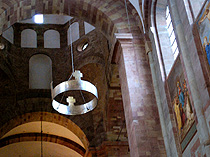 The Speyer
Cathedral is especially distinctive for its four high bell tower spires.
The town is often said it get its name from the spiers
of the cathedral, but was already called Spira by the Romans long before
a Christian church. The transept, choir square, apse and towers combine
in size to dwarf any design executed before with its double aisle gallery.
The Abbey at Cluny in Burgundy France was overall larger in footprint,
but has stood in ruins for centuries (see Abbey
Cluny Monastery),
and the Cathedral at Durham England where the style era is refered to
as "Norman" began construction shortly after and is near in scale
(see Durham
Cathedral). Speyer became a model for later
churches to follow, but never surpassed in its time, until the later
Gothic period. Inside,
Speyer's Imperial Cathedral is relatively unadornded, though the high
windows shining on upper nave wall paintings make it brighter than others
of its era, with parti-colored stone more similar to France (see Tournus
Abbey) than other German Cathedrals. An early imperial crown
ornament hangs from the high cieling as a reminder of the church's powerful
past.
The Speyer
Cathedral is especially distinctive for its four high bell tower spires.
The town is often said it get its name from the spiers
of the cathedral, but was already called Spira by the Romans long before
a Christian church. The transept, choir square, apse and towers combine
in size to dwarf any design executed before with its double aisle gallery.
The Abbey at Cluny in Burgundy France was overall larger in footprint,
but has stood in ruins for centuries (see Abbey
Cluny Monastery),
and the Cathedral at Durham England where the style era is refered to
as "Norman" began construction shortly after and is near in scale
(see Durham
Cathedral). Speyer became a model for later
churches to follow, but never surpassed in its time, until the later
Gothic period. Inside,
Speyer's Imperial Cathedral is relatively unadornded, though the high
windows shining on upper nave wall paintings make it brighter than others
of its era, with parti-colored stone more similar to France (see Tournus
Abbey) than other German Cathedrals. An early imperial crown
ornament hangs from the high cieling as a reminder of the church's powerful
past.
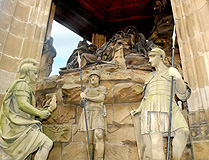 Outside
the Cathedral is the epic sculpture “The Mount of Olives” depicting
the ascencion. The
statue by local sculptor Gottfried Renn is from the 18th Century which
replaced
an
earlier one
from the
1400's which once stood in the center of the cathedral cloisters ruined
in a fire that consumed much of the town and destroyed a large section
of the cathedral nave in 1689. Behind the cathedral in the surrounding
park is a segment of medieval city wall standing at the edge of the slope
where the waters of the Rhine River would flood in earlier times. Across
from the entrance to the Speyer Cathedral is the fascinating Speyer Historical
Museum recounting the Roman, Medieval and Reformation history of Speyer,
and a walk or two bus stops away is the wondrous Speyer Technik Museum
(see Technik Museum).
Outside
the Cathedral is the epic sculpture “The Mount of Olives” depicting
the ascencion. The
statue by local sculptor Gottfried Renn is from the 18th Century which
replaced
an
earlier one
from the
1400's which once stood in the center of the cathedral cloisters ruined
in a fire that consumed much of the town and destroyed a large section
of the cathedral nave in 1689. Behind the cathedral in the surrounding
park is a segment of medieval city wall standing at the edge of the slope
where the waters of the Rhine River would flood in earlier times. Across
from the entrance to the Speyer Cathedral is the fascinating Speyer Historical
Museum recounting the Roman, Medieval and Reformation history of Speyer,
and a walk or two bus stops away is the wondrous Speyer Technik Museum
(see Technik Museum).
Palatine Genealogy Archive
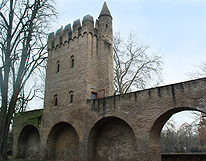 Next door
to the Catholic Cathedral of Speyer is the Protestant church archive
of records for
those ancestry researches looking for Palatine
genealogy history. A number of important marriages where held in the
cathedral, marked by the royal wives buried underneath, but in the 1500’s
Sabine of Bavaria, the sister of the Wittelsbach King Frederick III of
Palatine (Pfalz), married the Count Lamoral of Egmont in Holland at Speyer.
Count Egmont was beheaded in Brussels in the conflict between the Catholic
rulers of Burgundy and Spain and the converted protestant William of
Orange, leading to the independence of Flanders and the Netherlands (see Count
Egmont Brussels). Okay, I admit I only mention this
because he might be a relative, but I have some other Lutherans in the
records
at
Speyer as well.
Next door
to the Catholic Cathedral of Speyer is the Protestant church archive
of records for
those ancestry researches looking for Palatine
genealogy history. A number of important marriages where held in the
cathedral, marked by the royal wives buried underneath, but in the 1500’s
Sabine of Bavaria, the sister of the Wittelsbach King Frederick III of
Palatine (Pfalz), married the Count Lamoral of Egmont in Holland at Speyer.
Count Egmont was beheaded in Brussels in the conflict between the Catholic
rulers of Burgundy and Spain and the converted protestant William of
Orange, leading to the independence of Flanders and the Netherlands (see Count
Egmont Brussels). Okay, I admit I only mention this
because he might be a relative, but I have some other Lutherans in the
records
at
Speyer as well.
Visiting Speyer Cathedral
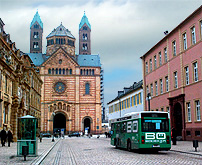 The Cathedral
stands at the end of Maximillian Strasse the central old city at the
opposite
end from the medieval “Old Gate”. A
bus line to the major tourist stops runs from in front of the main train
station (Hauptbahnhof) to the Cathedral and to the Technic Museum. Entrance
to the Speyer Cathedral is free. Open hours are Monday to Friday 9am
to 7pm, Saturday 9am to 6pm, and Sunday from 1:30 to 6pm from April to
October. In winter daily from 9am to 5pm. The Cathedral is closed to
tourists during church services, though joining services is allowed.
Speyer is near the vineyards of the Wine Road of the Palatine (German
Wine Road) and a short train ride from Heidelberg or Mannheim. © Bargain
Travel Europe
The Cathedral
stands at the end of Maximillian Strasse the central old city at the
opposite
end from the medieval “Old Gate”. A
bus line to the major tourist stops runs from in front of the main train
station (Hauptbahnhof) to the Cathedral and to the Technic Museum. Entrance
to the Speyer Cathedral is free. Open hours are Monday to Friday 9am
to 7pm, Saturday 9am to 6pm, and Sunday from 1:30 to 6pm from April to
October. In winter daily from 9am to 5pm. The Cathedral is closed to
tourists during church services, though joining services is allowed.
Speyer is near the vineyards of the Wine Road of the Palatine (German
Wine Road) and a short train ride from Heidelberg or Mannheim. © Bargain
Travel Europe
Find best vacation deals in the Rhineland on TripAdvisor
Web Info
Speyer
Cathedral
These articles are copyrighted and the sole property of Bargain Travel Europe and WLPV, LLC. and may not be copied or reprinted without permission.
See Also:
WILHELMSBAU MUSEUM MUSIC BOXES
WANDERING IMMIGRANTS - ANCESTRY RESEARCH
ST PETER AND ALEXANDER TREASURY - ASCHAFFENBURG
PRINCE BISHOP'S PALACE - BRUCHSAL

